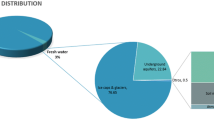Abstract
As recycling effluent from municipal sewage plants is technically a feasible way, this paper presents a mathematical model to analyze the extent to which effluent should be reclaimed for industrial use and examine the factor affecting reuse of reclaimed water. The resulting data shows that the low price of fresh water leads to reduced use of reclaimed water and impedes the investment of the effluent purification plant. A mandated regulation on the substitution rate of reclaimed water is suggested to impose on the industry. Theoretically, the optimal substitution rate as well as the water quality is determined by maximizing the total social welfare that results from the construction of conveyance channels and effluent purification plants. A case example is employed to derive the optimal substitution rate and water quality of reclaimed water. Through the numerical analysis, an effluent plant for treating 20,000 kl/day effluent with the substitution rate of 21.24 % is selected as the optimal solution.



Similar content being viewed by others
References
Aim RB (2012) Nnofiltration, reverse osmosis, forward osmosis and membrane distillation: 3rd lecture at Chia-nan University. Chia-nan University, Tainan
Bixio D, Thoeye C, Wintgens T, Hochstrat R, Melin T, Chikurel H, Aharoni A, Durham B (2006) Wastewater reclamation and reuse in the European Union and Israel: status quo and future prospects. Int Rev Environ Strateg 6(2):251–268
Carr G, Potter RB, Nortcliff S (2011) Water reuse for irrigation in Jordan: perceptions of water quality among farmers. Agric Water Manag 98:847–854
Cascetta F (1995) The water industry in Italy: state of the art and a comparison with other European community countries. Water Resour Manag 9(3):243–250
Cook S, Sharma A, Chong M (2013) Performance analysis of a communal residential rainwater system for potable supply: a case study in Brisbane, Australia. Water Resour Manag 27(14):4865–4876
Deason JP, Dickey GE, Kinnell JC, Shabman LA (2010) Integrated planning framework for urban river rehabilitation. J Water Resour Plan Manag 136(6):688–696
Fritzmann C, Löwenberg J, Wintgens T, Melin T (2007) State-of-the-art of reverse osmosis desalination. Desalination 216:1–76
Grigg NS (1999) Integrated water resources management: who should lead, who should pay? J Am Water Resour Assoc 35(3):527–534
GWI (Global Water Intelligence) (2012) Municipal water reuse markets 2010, http://www.globalwaterintel.com/
Hamilton AJ, Boland AM, Stevens D, Kelly J, Radcliffe J, Ziehrl A, Dillon P, Paulin B (2005) Position of the Australian horticultural industry with respect to the use of reclaimed water. Agric Water Manag 71:181–209
Hamoda MF (2004) Water strategies and potential of water reuse in the south Mediterranean countries. Desalination 165:31–41
Khosravi M, Gholikandi GB, Bali AS, Riahi R, Tashaouei HR (2011) Membrane process design for the reduction of wastewater color of the mazandaran pulp-paper industry, Iran. Water Resour Manag 25(12):2989–3004
Mao CC (2011) Report for the project of “reviewing criterion for sewerage system construction”. Environment and Development Foundation, Taipei
Margerum RD, Hooper BP (2001) Integrated environmental management: improving implementation through leverage point mapping. Soc Nat Resour 14:1–19
New Taipei Industrial Park Service Center (2013) http://www.moeaidb.gov.tw/iphw/wuku/
Palmer MA, Bernhardt ES, Allan JD, Lake PS, Alexander G, Brooks S, Carr J, Clayton S, Dahm CN, Follstadshan J, Galat DL, Loss SG, Goodwin P, Hart DD, Hassett B, Jenkinson R, Kondolf GM, Lave RE, Meyer JL, O’donnell TK, Pagano L, Sudduth E (2005) Standards for ecologically successful river restoration. J Appl Ecol 42(2):208–217
PUB, Singapore’s National Water Agency (2013) http://www.pub.gov.sg/about/historyfuture/Pages/NEWater.aspx
Qadir M, Bahri A, Sato T, Al-Karadsheh E (2010) Wastewater production, treatment, and irrigation in Middle East and North Africa. Irrig Drain Syst 24:37–51
Taiwan EPA (2013) http://www.epa.gov.tw/ch/aioshow.aspx?busin=235&path=10886&guid=af72fd8f-38d0-4bb2-a45f-d465643e4528&lang=zh-tw
Van der Bruggen B, Borghgraef K, Vinckier C (2010) Causes of water supply problems in urbanised regions in developing countries. Water Resour Manag 24(9):1885–1902
Water conservation information (2013) http://www.wcis.itri.org.tw/life/charge-3.asp
Water Resource Agency, MOEA (2013) http://www.wra.gov.tw/ct.asp?xItem=20062&ctNode=5292&comefrom=lp#5292
Yang H, Abbaspour KC (2007) Analysis of wastewater reuse potential in Beijing. Desalination 212:238–250
Author information
Authors and Affiliations
Corresponding author
Rights and permissions
About this article
Cite this article
Chen, YT., Chen, CC. The Optimal Reuse of Reclaimed Water: A Mathematical Model Analysis. Water Resour Manage 28, 2035–2048 (2014). https://doi.org/10.1007/s11269-014-0595-1
Received:
Accepted:
Published:
Issue Date:
DOI: https://doi.org/10.1007/s11269-014-0595-1




